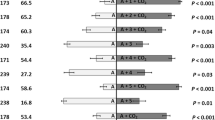Abstract
An olfactometer bioassay was used to follow attractant for screwworm flies,Cochliomyia hominivorax, in steam distillates of bovine blood under different distillation and storage conditions and after HPLC separation of components in a water-methanol gradient. In addition, fly responsiveness was examined in relation to sex and ovarian stage. Gravid and vitellogenic nullipars were attracted to the blood, although the former predominated four to one. Males did not respond at a dose that attracted 76% of gravid females. Maximum attractiveness occurred when distillate was stored in sealed glass ampoules. An argon atmosphere made storage at ambient temperatures feasible, but offered no advantage during storage at ca. −60°C or during distillation. The HPLC separation produced four fractions that duplicated the attractiveness of the distillate when recombined but showed little activity when presented as two-fraction, and most three-fraction, mixtures. Availability of the HPLC fractions for combination with other samples will facilitate location via bioassay of attractant components in samples obtained from subsequent or alternate isolations that preserve only one or two elements of the multicomponent mixture.
Similar content being viewed by others
References
Adams, T.S., andReinecke, J.P. 1979. The reproductive physiology of the screwworm,Cochliomyia hominivorax (Diptera: Calliphoridae) I. Oogenesis.J. Med. Entomol. 15:472–483.
Adams, T.S., Holt, G.G., andSundet, W.D. 1979. Physical and physiological effects on the response of female screwworms,Cochliomyia hominivorax (Diptera: Calliphoridae), to carrion odors in an olfactometer.J. Med. Entomol. 15:124–131.
Bellas, T.E., andBartell, R.J. 1983. Dose-response relationship for two components of the sex pheromone of lightbrown apple moth,Epiphyas postvittana (Lepidoptera: Tortricidae).J. Chem. Ecol. 9:715–725.
Bishopp, F.C. 1937. Flytraps and their operation. USDA Farmers' Bull. No. 734, 14 pp.
Bromel, M., Duh, F.M., Erdmann, G.R., Hammack, L., andGassner, G. 1983. Bacteria associated with the screwworm fly [Cochliomyia hominivorax (Coquerel)] and their metabolites.Endocytobiology 2:791–800.
DeVaney, J.A., Eddy, G.W., Ellis, E.M., andHarrington, R., Jr. 1973. Attractancy of inoculated and incubated bovine blood fractions to screwworm flies (Diptera: Calliphoridae): Role of bacteria.J. Med. Entomol. 10:591–595.
Eddy, G.W., DeVaney, J.A., andHandke, B.D. 1975. Response of the adult screwworm (Diptera: Calliphoridae) to bacteria-inoculated and incubated bovine blood in olfactometer and oviposition tests.J. Med. Entomol. 12:379–381.
Grabbe, R.R., andTurner, J.P. 1973. Screwworm attractants: Isolation and identification of organic compounds from bacterially inoculated and incubated blood.Folia Entomol. Mex. 25–26:120–121 (abstract).
Guillot, F.S., Coppedge, J.R., Goodenough, J.L., Adams, T.S., andAhrens, E. 1977. Behavior and reproductive status of native female screwworms attracted to a host.Ann. Entomol. Soc. Am. 70:588–590.
Guillot, F.S., Brown, H.E., andBroce, A.B. 1978. Behavior of sexually active male screwworm flies.Ann. Entomol. Soc. Am. 71:199–201.
Hammack, L. 1984. Relationships of larval rearing variables to fly attraction and oviposition responses in the screwworm,Cochliomyia hominivorax (Diptera: Calliphoridae).J. Med. Entomol. 21:351–356.
Hammack, L., andHolt, G.G. 1983. Responses of gravid screwworm flies,Cochliomyia hominivorax, to whole wounds, wound fluid, and a standard blood attractant in olfactometer tests.J. Chem. Ecol. 9:913–922.
Hammack, L., Bromel, M., Duh, F.M., andGassner, G. 1987. Reproductive factors affecting responses of the screwworm fly,Cochliomyia hominivorax (Diptera: Calliphoridae), to an attractant of bacterial origin.Ann. Entomol. Soc. Am. 80:775–780.
Jones, C.M., Oehler, D.D., Snow, J.W., andGrabbe, R.R. 1976. A chemical attractant for screwworm flies.J. Econ. Entomol. 69:389–391.
Knipling, E.F. 1979. The Basic Principles of Insect Population Suppression and Management. USDA Handbook No. 512, 659 pp.
Krafsur, E.S., Whitten, C.J., andNovy, J.E. 1987. Screwworm eradication in North and Central America.Parasitol. Today 3:131–137.
Snow, J.W., Coppedge, J.R., Broce, A.B., Goodenough, J.L., andBrown, H.E. 1982. Swormlure: Development and use in detection and suppression systems for adult screwworm (Diptera: Calliphoridae).Bull. Entomol. Soc. Am. 28:277–284.
Steel, R.G.D., andTorrie, J.H. 1960. Principles and Procedures of Statistics. McGraw-Hill, New York, 481 pp.
Author information
Authors and Affiliations
Additional information
Mention of a proprietary product does not constitute an endorsement or recommendation for its use by the USDA.
Rights and permissions
About this article
Cite this article
Hammack, L., Pomonis, J.G., Flath, R.A. et al. Multicomponent attractant for female screwworm flies,Cochliomyia hominivorax, in bovine blood. J Chem Ecol 15, 25–36 (1989). https://doi.org/10.1007/BF02027771
Received:
Accepted:
Issue Date:
DOI: https://doi.org/10.1007/BF02027771




